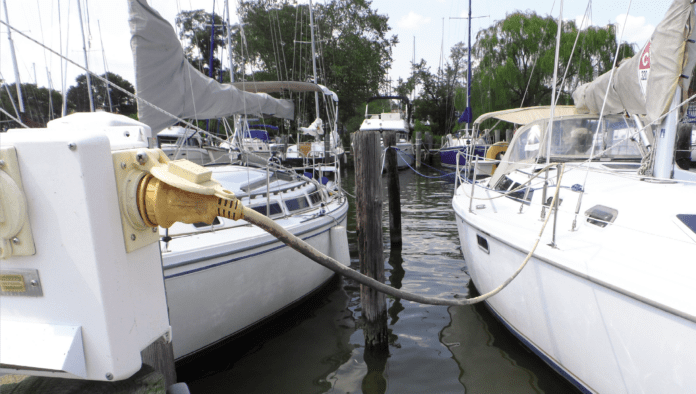
Power pedestals are handy and safe when they match the power requirements of the boat. Thirty amps for a 30-amp boat. Fifty amps for a 50-amp boat. But what about when they don’t match? Weaving your way through the requirements can be complicated, often difficult, and sometimes just impossible. We saw some scary stuff while collecting images for this article, and we didn’t have to walk far.
One of the first things I did when downsizing from a cruising cat to a 24-ft. trimaran was add a simple solar system to keep the battery charged and free us from shorepower. I could have installed a small AC-powered battery charger, but this worked better for my situation.
As a side note, there are some caveats to going the solar-only route. Some setups can eventually reduce battery capacity (see “Fighting Sulfation in AGM Batteries”). However, since I don’t have a lot of power-hungry systems on this boat, and I rarely let the capacity drop below 85 percent, this is not a major issue for me. I also have the option of connecting a portable battery charger to bring the batteries up to full charge as needed to prevent sulfation.
Getting back to adapters. Going up in amperage from the plug to the boat primarily means you can’t run all your appliances at once without popping a pedestal breaker. A 50-amp boat plugged into a 30-amp circuit may have to choose between running the dryer and air conditioning, or at least delay laundry until the battery charger has dropped down from peak load.
You will also be operating closer to the current-carrying capacity of the pedestal and attached plug and converter. This means special precautions are in order. The adapter must be fitted with weatherproof connectors at both ends, which is very rare. The plugs must be clean and greased to prevent corrosion. Periodically rinse male plugs with tap water and dry them to prevent salt buildup. There’s not much you can do about the female part, other than keep it protected at all times and clean off the male part.
The locking rings are often broken or missing. They are a $12 replacement item. The replacements will slip over the end, but require considerable effort. It helps if the rings are warm and lubricated. (A little KY jelly or non-petroleum grease works.) If the receptacle thread is broken, contact the marina to get it fixed.
Going down in amperage from the receptacle directly to the boat (or other tool or accessory) creates a different kind of risk. A 50-amp supply can overheat a 30-amp cord going to a 30-amp boat, and a 30-amp supply can overheat a
15-amp cord. In principle, the boat has a breaker that is sized to prevent excess current coming from the pedestal, but that does not protect the cord itself, should the cord become damaged.
Of course, the offending short circuit that might escape traditional over-current protection must be in the Goldilocks range—not so small as to stay within the cord rating, and not a dead short that which would trip the breaker instantly. But this is possible.
For example, one of the plugs could become carbonized and begin heating. A minor chafe failure can also create a partial short that doesn’t trip the main breaker. This same risk is present with every household lamp; the cord is rated for less than 15 amps, but is plugged into 15-amp outlet. But there is an important difference—houses are not constantly moving, and living rooms are not exposed to weather.
In fact, extension cords routed under carpets, where they can build heat and chafe without anyone noticing it, are responsible for many house fires. This is why the American Boat and Yacht Council (ABYC) and the National Electronic Code (NEC) only allow step-down adapters for temporary use with power tools and accessories.
RISKS OF SHOREPOWER
Plugging a 15-amp boat into a 30-amp plug introduces two risks. First, there is overheating the cord. You can use a cord with a breaker on the male end to prevent this, but there is no way to weatherproof this plug where it connects to the 30-15 amp adapter. Power strips installed the boat end commonly have circuit breakers, but they do not protect the wire from a short caused by an exposed wire. The other risk of plugging a 15-amp boat into a 30-amp plug is a short introduced at the plug itself. A typical 15-amp plug does not have any weather-proofing features.
Both of the above problems can be solved by running a 30-amp cord direction into the boat cabin and then plugging in the 15-amp adapter, but you will still need overcurrent protection (a 15-amp breaker) on the boat.
Long term, the best answer is to install a 30-amp plug receptacle, breaker panel and wiring in your small boat. The cost is about $500 in parts (inlet receptacle, basic panel, breakers and wire). A professional installation would run about $1,000. I can see why it is not always done.
LIVING WITH 15-AMP RECEPTACLES
Ice melters are commonly plugged into 30-amp outlets using adapters. Some are plugged into 15-amp receptacles without special weatherproofing, and you can bet they are not inspected often in the winter. The ice melters typically have three-wire cords—either 12-gauge (12 AWG) or 14-gauge (14 AWG)—and these cords move just like a boat in a slip, but perhaps without the combustible fiberglass on the other end.
If your slip provides only a 15-amp receptacle, your choices are limited. I kept a 30-amp boat in a marina with 15-amp plugs for a decade.
I added a weatherproof hood to the outlet, wrapped the heavy duty 12-gauge (12 AWG) cord around a piling as strain relief, and spliced a 30-amp female pigtail to the boat end. To make the splice I used crimp connectors, heat shrink on each conductor, and two staggered layers of heat shrink over the cord to cover the insulated wires where the jacket was stripped away. And I always watch my amps like a hawk.
I also added an internally protected ground fault interrupt receptacle (GFI) on the dock pedestal and on the boat. Boaters should be aware that GFI outlets will trip occasionally from rain if the plugs are not protected by an outlet cover designed for protecing plugs while they are in in-use. Flapper-type covers protect the outlet, but are not weather proof when they are in-use.
Currently, I have a smaller boat with no shorepower receptacle, and I have the seasonal need to run a dehumidifier. Again, I added a weatherproof hood to the dock outlet. I use a heavy duty cord, wrap it around a piling for strain relief, and sneak it in through the companionway.
I provide a drip loop just inside the companionway. This is so that if any water should follow the cord into the boat, it drips into the bilge and doesn’t continue on to the plug end. The dehumidifier sits on the stove, where it can be left untended with very little fire risk. The tiny dehumidifier pulls less than one amp, so cord or plug heating is unlikely. Because they draw far more amps and are notorious for starting fires, I would never leave a heater unattended in this way.
OTHER SHORE POWER NOTES
No matter what type of connector or cord you are using, some simple precautions can help reduce the risk of fire or damage to the electrical system.
Connecting. Always turn the pedestal breaker off when connecting. If the supply breaker is not accessible, turn off the boat’s main breaker. Arcing damages the plug, and damaged plugs overheat.
Avoid salt contamination. If a plug falls in the water, unplug and remove immediately, rinse with tap water and dry. Salt leads to corrosion, high resistance, shorting and overheating.
Unplug. Never leave a shore power or extension cord plugged in to the pedestal when the boat is away. The other end can fall in the water, creating a hazard. Just a few minutes in saltwater will melt the end of the cord, generally without blowing the breaker. Unplug it from the pedestal.
Watch for pinch points. For example, it is common for a cord to get between a piling and a dockline and become chafed.
Alternatives. One of the best solutions to a sketchy shorepower setup is energy independence. Don’t plug in. A simple solar system, no more than a 50-watt panel and cheap charge controller, can free many smaller boats from the trouble of plugging in. It will handle some overnight cruises and can power the sump pump when dock power dies due to thunderstorms or ice storms. I have not depended on shorepower alone for 20 years, cruising boat, or day boat.
Heater risk. Of course, the greatest risk is leaving a space heater running in the winter. It can tip, something can fall into it, or it can just plain fail. Space heaters also run too close the limit for 15-amp plugs (they draw 12.5 amps at the 1,500-watt setting) for continuous service.
Avoid RV options. There are many cord adapter combinations that are acceptable for use on recreational vehicles. But this is different from boats. These vehicles are usually attended, and the RV is not constantly moving with the waves. Most likely, the cord is lying on gravel, where it poses minimal fire risk. Just because land yachts can use a product does not mean boaters should.
CONCLUSION
The best solution is to match the inlet to the available supply, but cruise a little and you will be faced with mismatches. Recognize the hazards introduced by every adapter and take steps to mitigate them.
If you have a 50-amp boat and must plug into a 30-amp pedestal, use locking connectors and keep a close eye on your power draw, trying hard to stay below about 20 amps (the most that is safe for continuous use). Same goes for a 30-amp boat plugged into 50 amps; use locking adapters and watch your cord for chafe.
Small boats may be best served by installing a small solar panel and not plugging in at all. If your marina caters to smaller boats and has 15-amp outlets rather than the 30-amp power pedestals required by the electrical code, at the very least make sure it is GFCI, that the cover is weatherproof in-use, and that you use a first quality #12 cord. Install it with strain relief and careful attention to chafe, and down-cycle it to yard use every few years, when the UV damage and wear first begin to show.
TECH GUIDE: COMPARING 15-AMP SHOREPOWER ADAPTERS
| MANUFACTURER | HALEX | PARKWORLD | MARINCO | MARINCO | MARINCO | MARINCO | TAYMAC |
|---|---|---|---|---|---|---|---|
| DESCRIPTION | 30-50 pigtail adapter | 50-30 pigtail adapter | Straight adapter | Pigtail adapter | Pigtail 3-plug adapter with GFI | Pigtail adapter | MM410C Cover and Receptacle |
| RECEPTICAL | 30 amps | 30 amps | 30 amps | 30 amps | 30 amps | 15 amps | 15 |
| PLUG | 50 amps | 50 amps | 15 amps | 15 amps | 15 amps | 30 amps | NA |
| WEATHERPROOF RECEPTACLE END | Yes | Yes | No | Yes | No | No | Yes |
| WEATHERPROOF PLUG END | Yes | Yes | No | No | No | Yes | NA |
| LOCKING RECEPTACLE END | Yes | Yes | Yes | Yes | No | No | No but has partial restraint |
| LOCKING PLUG END | Yes | Yes | No | No | No | Yes | NA |
| OVERCURRENT PROTECTION | Yes | No | No | No | Yes | Yes | NA |
| COMMENTS | Watch your amps | Wire not protected against overcurrent | Wire not protected against overcurrent | Wire not protected against overcurrent | For use with tools; extension cords not protected against overcurrent | Watch your amps, for temporary on-shore use only | Any receptical that my be plugged in during rain should have an in-use cover |
| MEETS NEC FOR SHOREPOWER | Yes | No | No | No | No | No | No |
| COMMENTS | |||||||
| PRICE | $46.00 | $50.00 | $42.00 | $48.00 | $96.00 | $48.00 | $11.00 |
There is no shorepower standard or allowance for household-style 15-amp plugs of any kind. You can buy 15-amp inlets for bass boats, but they are only rated for use when out of the water. The two primary standards that guide shorepower hookups are ABYC Standard E-11 (American Boat and Yacht Council), and NEC article 555 (National Electrical Code).
CODE HIGHLIGHTS
• No receptacle less than 30 amperes (NEC).
• There must be strain relief for plugs and cords.
• Connectors must meet UL498M, which covers 20- to 50-amp, locking, weatherproof, grounded connectors (ABYC).
• The ENC lists the receptacles that are acceptable for providing weather protection. Makers often indicate this compliance.
• Each receptacle must have a separate breaker. The breaker or disconnect must be located within 30 inches of the receptacle (NEC).
• Connectors of locking and grounding type only.
• Boat-side receptacle must be weatherproof and locking, and also waterproof if subject to flooding.
• All 15- and 20-amp receptacles must be GFI type (5 mA leakage to trip). Beginning in 2011 GFI (also known as Equipment Leakage Circuit Interrupters) was expanded to include 30- and 50-amp circuits (30 mA to trip). Note that the 30mA shore power limit is six times the 5 mA limit that is required for for 15-amp circuits on power tools. So these receptacles are not sufficiently protective on their own. For example, at 16 amps muscles will spasm so that you can’t let go of the current carrying device or whatever conductor (bow rail, etc.) involved in the short, and at 30 mA breathing becomes impossible.
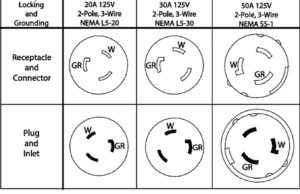
1. Marina power pedestals are typically fitted with one of the illustrated plug types (as represented in the ABYC Standards), one for each amperage rating. Cords rated at 30A and 50A are most common.
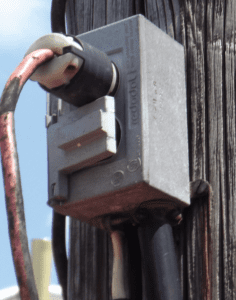
2. This example is about as bad as it gets for 15-amp service at a marina. There is no weather protection for the connector, the plug is botched, there’s no strain relief, and the cord is heavily chafed.
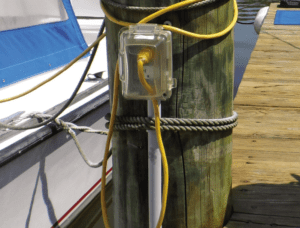
3. Probably the best available measure for protecting 15-amp service is a weatherproof cover that provides protection while the cord is plugged in. A few wraps around the piling provide strain relief.

Sailors have a lot of options when choosing adaptors. We’ve tested products from Hubbel, Marinco, and Smartplug. All of the manufacturers in this field cater to both the recreational and the marine market.
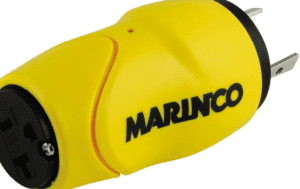
1. Marinco’s straight adapter steps down from 30 amp to 15 amp. It does not lock in place.
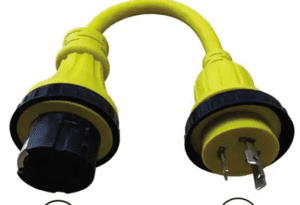
2. Halex’s weatherproof 30-50A adapter is weatherproof, locking, and the downstream wire is larger than competitor’s adapters.

3. Marinco’s 30A-15A adapter has a locking plug at the receptacle end.
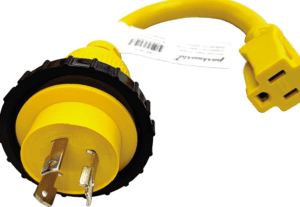
4. Parkworld’s 30A-15A pigtail adapter is similar to Marinco’s, but about $20 cheaper.
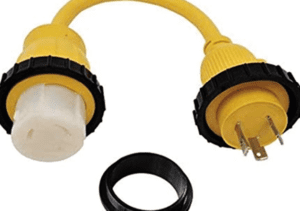
5. Parkworld’s pigtail 50Amp to 30 amp adapter has locking rings on both ends.
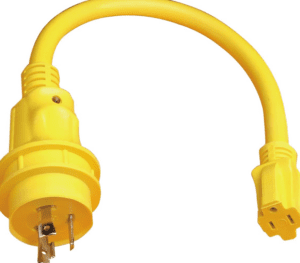
6. Marinco’s straight pigtail adapter drops 30 amps down to 15 amps. It has an indicator light that shows when it is energized.
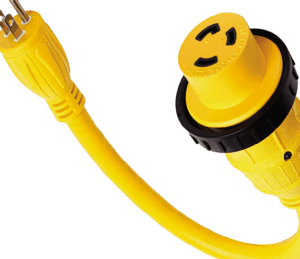
7. Marinco’s pigtail adapter connects a dockside 15-amp outlet to 30-amp shorepower cord, with a locking connection at one end.

8. The Powerall extension cord has a a 15-amp breaker built into the plug.

Shore power mis-matches and 15-amp services are often hard to avoid, but you can make the best of it or you can create a real hazard. Here are several examples of disasters waiting to happen, some minor oversights, and some acceptable compromises.
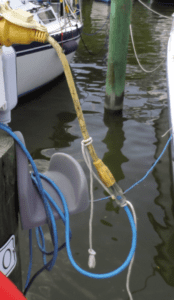
1. At least the owner has made an effort to relieve strain at the adapter plug. The biggest problem, as it is with most 15-amp service challenges, is waterproofing.
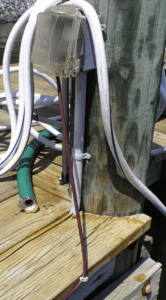
2. Cover won’t close and cord is so tight, the plug is at an angle. The u-clamps supporting the cord should be padded to prevent chafe.
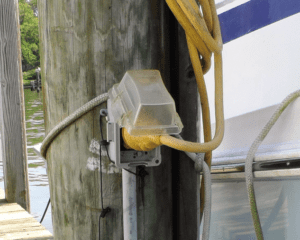
3. A weatherproof cover makes little sense if you can’t close it.

4. Here’s an outlet with GFI protection, strain relief, and a cover that can close with the cord in use. The cord could be a bigger size, and the 15-amp breaker is too far away.
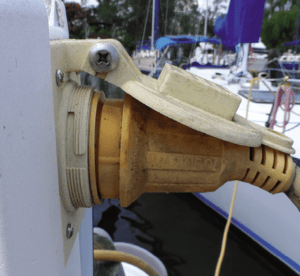
5. Missing locking rings are common. They are replaceable.

6. This plug has no cover, no strain relief, and no strain relief.
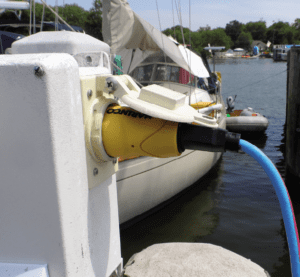
7. The flapper-style receptacles are weatherproof only when closed, not while they are in use.

8. Many cords lack their locking rings despite them being easily replaced.
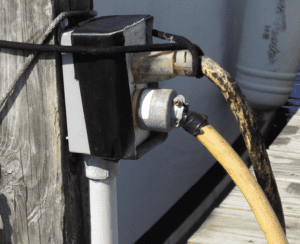
9. Oh dear. There is not a single thing done right here. The owner has made a feeble attempt at supporting the power cord, but both cords look to be in terrible conditions, with token electrical tape as a solution.

10. Another “oh, dear.” Anyone at this end of the marina had better have a fire extinguisher handy.








































How can you write an entire article about shore power safety in 2022 without mentioning the SmartPlug?
The article was focused on dockside (pedestal) misuse of 30- and 50-amp twist locks, and and on 15-amp alternatives. While SmartPlugs are becoming more common on boats, they are still very rare pedestals.
That said, as Smart Plugs age we are starting to hear of scattered failures and one fire that we are aware of. Like other plugs, if they are not supported properly they can wear, corrode, and overheat. Twist locks can last decades if properly maintained. We are watching the issue, but please remember that a Smart Plug is not a cure-all for poor practices. You still need to keep the contacts clean and maintain proper support.
Seems like all the more reason to mention it.
I don’t understand how a higher amperage supply can burn out a lower amperage system that it is supplying, unless the lower amperage system tries to draw more than its rated amperage. A 50 amp supply only supplies as many amps as are demanded. If your boat demands a maximum of 30, you will have at most 30 amps going through a system rated for 30 amps, regardless of the capacity for the supply to provide more. The power being consumed and transmitted through the 30 amp system is 30 amps x 120 volts regardless of whether the supply is capable of supplying only 30 amps or could, if demanded, supply 50. Plug a 5 amp appliance into a 15 amp household circuit and you don’t burn it out; you still just draw 5 amps. If your 15 amp boat pulls into a harbour with 50 amp outlets, it still just draws up to 15 amps. Am I missing something?
Easily. If a 30-amp cord or adapter is connected to a 50-amp pedestal, when a slight short develops in either the wire (chafe) or the plug (salt not flushed from the socket–very common) the current will exceed the rating of the wire, but not the rating of the pedestal breaker. Yes, the boat will only draw what the boat’s entrance breaker allows, but the cord and plug are not protected against any short on the land side of the boat entrance breaker. Overheated plugs and cords are common initiators for boat and dock fires.
The 15-amp boat draws less than 15 amps, but the cord and plug can draw far more if damaged or contaminated with salt, followed by overheating and fire. Breakers are sized to protect the wiring, not the appliance.
This is a common misunderstanding and was one of the primary motivations for writing the article.
Okay, makes sense – for shorts and failures causing over-draw in the line compared to the boat’s wire rating but below the shore breaker rating. Thanks for the clarification. Although physical degradation from friction occasionally takes place, in my freshwater, 6 month environs you would almost never see corrosion of plugs or electrical hardware to any degree within a season. I guess one of the advantages of a short season is that all these systems get disconnected or reconnected twice a year, so potential problems are noticed relatively early.
That said, I’ve noticed corrosion and physical degradation on the DC side from time to time, so I’ve added a lot of inline fuses to the 12 volt side of my boat. My bilge pump was wired directly to one battery with no fuse at all, for example, and I noticed some connectors corroding badly. Galvanic effect of DC voltage likely causes or adds to this problem, and it seems in the early 80’s very little attention was paid to the potential for low voltage wires to chafe or break, and most wires were not tinned either.
Overall I’m in favour of less, rather than more, powered systems on a boat, so this trend to higher and higher shore power ratings seems to me to be going in the wrong direction; with electric vehicles and constantly increased tech, where are we going to get electrical power other than by further destructive fossil fuel burning? 50 amps is enough for a cottage or house, the idea of a washing and dryer and big screen TV on a recreational boat boggles my mind – hand wash in a pail and hang it on the lifelines to dry! But I digress …
Cheers and safe sailing!
You have not addressed the issue of gfi breakers and splitters. Our marina has been rewired with all 30 Amp outlets on gfi breakers. Previously boats with 50 Amp requirements used a splitter so th
I was not finished and accidently posted – using a splitter that handles the 50 Amp cord by plugging into two 30 Amp outlets doesn’t work with gfi breakers since the split current won’t necessarily be evenly shared thus tripping the gfi.
Dielectric (bulb) grease placed on both the male and female ends prevents corrosions and the dangerous overheating caused by high resistance connections. An ounce of prevention. Dielectric grease is the right material for the job, not KY jelly. Available at auto supply stores for under $10. Use the stuff on every electrical connection on the boat.
Every boat at my yacht club leaves the power cord attached and powered when the owner is not present. People want the battery charger and fridge to be powered. Maybe we have had a twenty year streak of good luck, but so far there have been no shore power electrical fires. These are marine 30 and 50 amp services and cords.
^^ The KY was NOT suggested for the electrical contacts. The KY was suggested to help slide a replacement locking ring into place when the old one cracks. KY was invented as a surgical lube and is very good for sliding plastic and rubber parts into place, after which it rinses away.
PS has reviewed anti-corrosion greases, including dielectric greases, in the past. One of the best contact greases is actually slightly conductive (No-Ox-Id by Sanchem).
“The locking rings are often broken or missing. They are a $12 replacement item. The replacements will slip over the end, but require considerable effort. It helps if the rings are warm and lubricated. (A little KY jelly or non-petroleum grease works.) If the receptacle thread is broken, contact the marina to get it fixed.”
Please provide editorial on ‘Electrocution Drowning’. I occasionally see people swimming off docks where there is shore power in use. People don’t understand the possible consequences. When people die from swimming off a dock it is ruled a drowning which is correct. But the cause may have been inability to move or call out from stray electrical current. Thanx.
Richard: Please see “Preventing Electric Shock at Dock,” August 20, 2019 and “Staying Safe While Working Underwater,” December 2020.
Yes, these are important concerns. The hazard is most severe in fresh water, but everyone could use a reminder.